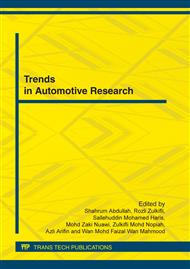p.6
p.12
p.16
p.21
p.26
p.31
p.38
p.43
p.48
Fatigue Life Assessment of Aluminium Alloy 6061 Specimen Using Signal Analysis Approach for Automotive Components
Abstract:
This paper is aimed to investigate the fatigue assessment of aluminium alloy 6061specimen, one of the widely used aluminium alloys in the production of mechanical components. The alloy possesses the ability of critical failure caused by fatigue when they are subjected to dynamic responses in automotive-type components. The specimens were prepared according to the ASTM E606 and ASTM E1820 standards which were then subjected to two types of cyclic loading amplitude modes namely constant amplitude and random amplitude. The effort is initiated by implementing fatigue data editing approach for random amplitude signal, the conventional method, the finite element method (FEM) and fatigue assessment determination through the statistical method of root mean square (r.m.s) and kurtosis. The input and edited signal acquired will be analyzed for the prediction of the fatigue damage based on the strain model approaches, i.e. Coffin-Manson, Morrow and SWT. From the results obtained, both edited and non-edited signals load display the same amount of fatigue damage to consequently decrease the analysis duration. In addition, the FEM was found to be the best approach for estimating the fatigue life. This research has finally revealed that the higher cyclic load amplitude will only diminish the fatigue life of a specimen. Furthermore, this fatigue assessment study will look forward to improve structural engineering development in monitoring components and consequently access the damage prediction variable which could later be implemented to the manufacturing industry.
Info:
Periodical:
Pages:
26-30
Citation:
Online since:
April 2012
Authors:
Price:
Сopyright:
© 2012 Trans Tech Publications Ltd. All Rights Reserved
Share:
Citation:


